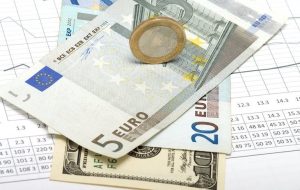Euro remains weak, puts the 1.0550 zone to the test
Share: The Euro trades on the defensive against the US Dollar. Stocks in Europe close the session with marked losses. EUR/USD loses some momentum and slips back to 1.0550. The USD Index (DXY) looks bid in the low 106.00s. Eurozone final inflation figures matched the preliminary readings. Housing Starts expanded 7.0% MoM in September. The

- The Euro trades on the defensive against the US Dollar.
- Stocks in Europe close the session with marked losses.
- EUR/USD loses some momentum and slips back to 1.0550.
- The USD Index (DXY) looks bid in the low 106.00s.
- Eurozone final inflation figures matched the preliminary readings.
- Housing Starts expanded 7.0% MoM in September.
The Euro (EUR) encounters selling pressure in its exchange with the US Dollar (USD), resulting in EUR/USD declining to the 1.0550 area on Wednesday.
Meanwhile, the Greenback maintains its position in the low 106.00s, as measured by the USD Index (DXY), amid the overall indecisive price movement in global markets. This occurs amidst a prevailing cautious sentiment due to escalating geopolitical risks.
Continuing to centre attention on monetary policy, investors anticipate that the Federal Reserve (Fed) will uphold its position of not touching interest rates throughout the remainder of the year. Meanwhile, participants in the financial markets contemplate the possibility of the European Central Bank (ECB) halting policy modifications, despite inflation levels surpassing the bank’s target and mounting concerns about the potential for an economic downturn or stagflation in the region.
On the domestic calendar, the final Inflation Rate for September in the broader Eurozone saw the CPI rise 4.3% YoY and 4.5% YoY when it came to the Core CPI (consumer prices excluding food and energy costs).
Data-wise, in the US, the usual weekly Mortgage Applications tracked by MBA contracted 6.9% in the week to Ocotber 13, while Housing Starts increased 7% MoM in September (1.358M units) and Building Permits contracted 4.4% MoM (1.473M units). In addition, the Fed’s Beige Book and TIC Flows are also due.
Additionally, markets’ attention will also be on speeches by FOMC Governor Christopher Waller (permanent voter, centrist), NY Fed President John Williams (permanent voter, centrist), FOMC Governor Michelle Bowman (permanent voter, hawk), and Philly Fed President Patrick Harker (voter, hawk).
Daily digest market movers: Euro struggles to regain upside traction
- The EUR trades with modest losses against the USD.
- US and German yields now leave behind initial losses.
- Markets remain focused on the Fed’s tighter-for-longer stance.
- Investors see the ECB could pause its tightening cycle until Q3 2024.
- The crisis in the Middle East could get worse before it gets better.
- Chinese data surprised to the upside.
- UK CPI rose 6.7% YoY in September, a tad above estimates.
Technical Analysis: Euro retargets the 1.0500 support and below
EUR/USD trades in an inconclusive fashion around 1.0570 against the backdrop of a lack of direction in the Greenback.
If the rising trend continues, EUR/USD may revisit the October 12 high of 1.0639, as well as the September 20 top of 1.0736 and the significant 200-day Simple Moving Average (SMA) of 1.0820. A break above this level might signal an effort to break above the August 30 peak of 1.0945 and target the psychological level of 1.1000. Any more gains over the August 10 high of 1.1064 might take the pair towards the July 27 top of 1.1149 and possibly the 2023 peak of 1.1275 seen on July 18.
In the case that selling pressure persists, the 2023 low at 1.0448 from October 3 might be revisited, as well as the major support of 1.0400. If this level is broken, it may pave the way for a retest of the weekly lows of 1.0290 (November 30, 2022) and 1.0222 (November 21, 2022).
As long as the EUR/USD continues below the 200-day SMA, the possibility of continuous bearish pressure exists.
Euro FAQs
The Euro is the currency for the 20 European Union countries that belong to the Eurozone. It is the second most heavily traded currency in the world behind the US Dollar. In 2022, it accounted for 31% of all foreign exchange transactions, with an average daily turnover of over $2.2 trillion a day.
EUR/USD is the most heavily traded currency pair in the world, accounting for an estimated 30% off all transactions, followed by EUR/JPY (4%), EUR/GBP (3%) and EUR/AUD (2%).
The European Central Bank (ECB) in Frankfurt, Germany, is the reserve bank for the Eurozone. The ECB sets interest rates and manages monetary policy.
The ECB’s primary mandate is to maintain price stability, which means either controlling inflation or stimulating growth. Its primary tool is the raising or lowering of interest rates. Relatively high interest rates – or the expectation of higher rates – will usually benefit the Euro and vice versa.
The ECB Governing Council makes monetary policy decisions at meetings held eight times a year. Decisions are made by heads of the Eurozone national banks and six permanent members, including the President of the ECB, Christine Lagarde.
Eurozone inflation data, measured by the Harmonized Index of Consumer Prices (HICP), is an important econometric for the Euro. If inflation rises more than expected, especially if above the ECB’s 2% target, it obliges the ECB to raise interest rates to bring it back under control.
Relatively high interest rates compared to its counterparts will usually benefit the Euro, as it makes the region more attractive as a place for global investors to park their money.
Data releases gauge the health of the economy and can impact on the Euro. Indicators such as GDP, Manufacturing and Services PMIs, employment, and consumer sentiment surveys can all influence the direction of the single currency.
A strong economy is good for the Euro. Not only does it attract more foreign investment but it may encourage the ECB to put up interest rates, which will directly strengthen the Euro. Otherwise, if economic data is weak, the Euro is likely to fall.
Economic data for the four largest economies in the euro area (Germany, France, Italy and Spain) are especially significant, as they account for 75% of the Eurozone’s economy.
Another significant data release for the Euro is the Trade Balance. This indicator measures the difference between what a country earns from its exports and what it spends on imports over a given period.
If a country produces highly sought after exports then its currency will gain in value purely from the extra demand created from foreign buyers seeking to purchase these goods. Therefore, a positive net Trade Balance strengthens a currency and vice versa for a negative balance.
 آموزش مجازی مدیریت عالی حرفه ای کسب و کار Post DBA آموزش مجازی مدیریت عالی حرفه ای کسب و کار Post DBA+ مدرک معتبر قابل ترجمه رسمی با مهر دادگستری و وزارت امور خارجه |  آموزش مجازی مدیریت عالی و حرفه ای کسب و کار DBA آموزش مجازی مدیریت عالی و حرفه ای کسب و کار DBA+ مدرک معتبر قابل ترجمه رسمی با مهر دادگستری و وزارت امور خارجه |  آموزش مجازی مدیریت کسب و کار MBA آموزش مجازی مدیریت کسب و کار MBA+ مدرک معتبر قابل ترجمه رسمی با مهر دادگستری و وزارت امور خارجه |
 مدیریت حرفه ای کافی شاپ |  حقوقدان خبره |  سرآشپز حرفه ای |
 آموزش مجازی تعمیرات موبایل آموزش مجازی تعمیرات موبایل |  آموزش مجازی ICDL مهارت های رایانه کار درجه یک و دو |  آموزش مجازی کارشناس معاملات املاک_ مشاور املاک آموزش مجازی کارشناس معاملات املاک_ مشاور املاک |
- نظرات ارسال شده توسط شما، پس از تایید توسط مدیران سایت منتشر خواهد شد.
- نظراتی که حاوی تهمت یا افترا باشد منتشر نخواهد شد.
- نظراتی که به غیر از زبان فارسی یا غیر مرتبط با خبر باشد منتشر نخواهد شد.





ارسال نظر شما
مجموع نظرات : 0 در انتظار بررسی : 0 انتشار یافته : ۰